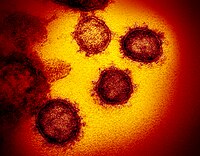
Photo from wikipedia
Immune responses and central nervous system dysfunction are two main factors to be considered during rabies virus (RABV) infection. However, the mechanisms by which RABV strains of different virulence regulate… Click to show full abstract
Immune responses and central nervous system dysfunction are two main factors to be considered during rabies virus (RABV) infection. However, the mechanisms by which RABV strains of different virulence regulate with chemokine expression and the signaling pathways responsible for the immune responses in the terminal stage of infection both in vivo and in vitro have not been fully elucidated. In this study, we found low expression levels of proinflammatory chemokines in the mouse brain upon infection with street RABV strains (CXZ17 and HN10) at the late stage of infection. We also examined the difference in inflammatory response upon infection with RABV strains of different virulence in a mouse model. We found that the expression of proinflammatory chemokines increased to a varying degree upon infection with street RABV (CXZ17 and HN10) or laboratory-fixed RABV (CVS-11, aG, and CTN); CXCL10, CCL5, and CCL2 were the most significantly upregulated chemokines in brain tissue and microglial BV-2 cells in response to infection with RABV strains of different virulence. Our data also demonstrate significant activation of the MAPK and NF-κB pathways in mouse brain tissue at the late stage of RABV infection. We also found (i) low phosphorylation signals of MAPK and NF-κB p65 in neuronal cells upon infection with CXZ17 and HN10 in the mouse brain and (ii) strong phosphorylation signals in cerebrovascular endothelial cells and neuronal cells upon CTN or aG infection. Moreover, we quantified the nuclear localization status of MAPK signals and NF-κB p65 upon infection with CVS-11, aG, and CTN in BV-2 cells in vitro. We also found (i) that the activation of the p38, ERK1/2, and NF-κB p65 pathway, which stimulates CXCL10, CCL5, and CCL2 expression upon infection with RABV strains of different virulence (aG, CTN, and CVS-11), is triggered after virus entry into BV-2 cells and (ii) that the expression of CXCL10, CCL5, and CCL2 is required for the activation of NF-κB, p38, and ERK1/2, but not JNK. Overall, our study provides insight into the regulation of inflammatory responses mediated by MAPK and NF-κB in the mouse brain and in microglial cells upon RABV infection of different virulence.
Journal Title: Molecular immunology
Year Published: 2020
Link to full text (if available)
Share on Social Media: Sign Up to like & get
recommendations!